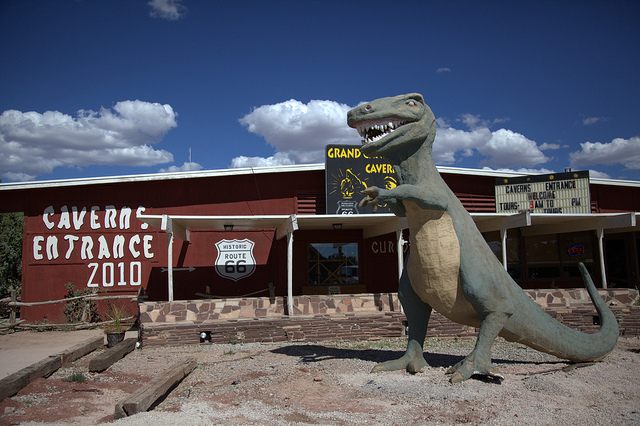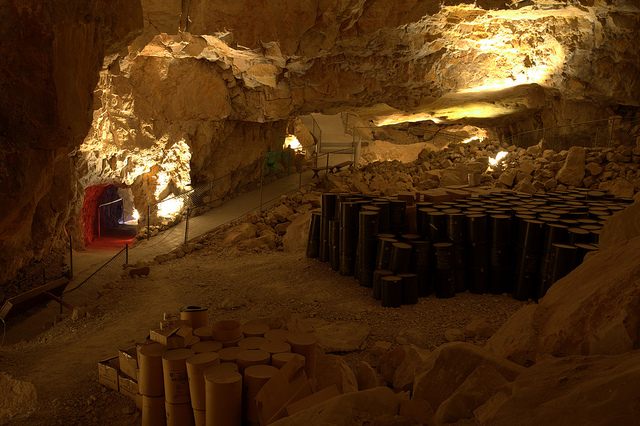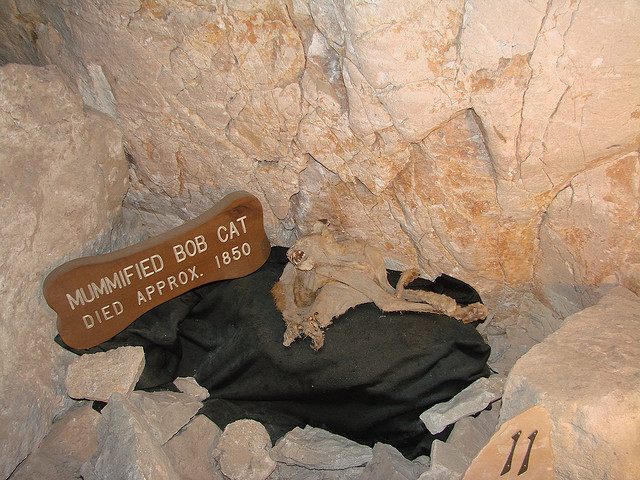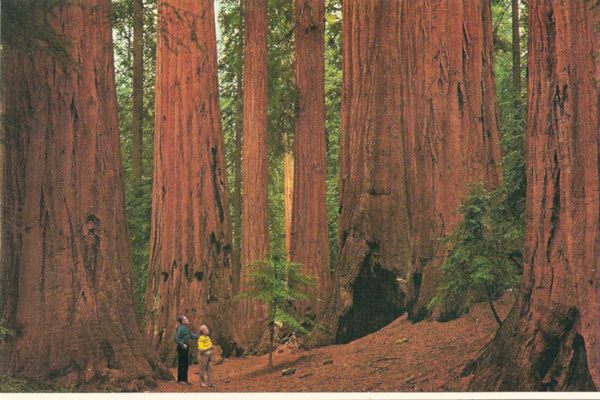The Grand Canyon Luxury Suite That Is Also A Cave
 The Underground Cavern Suite. (Photo: Courtesy Grand Canyon Caverns)
The Underground Cavern Suite. (Photo: Courtesy Grand Canyon Caverns)
Usually, the word “cavernous” wouldn’t be the highest praise you could pay a hotel room—adjectives like “cozy” or “luxurious” excite hospitality professionals more. But in the case of the Cavern Suite, it’s not only a compliment, it’s accurate.
The accommodations are located 200 feet below ground in the Grand Canyon Caverns in Peach Springs, AZ and billed as “the oldest, darkest, deepest, quietest, and largest suite room in the world.”
In 1927 a woodcutter named Walter Peck either nearly fell or did fall (accounts differ on Peck’s degree of clumsiness) into a hole that opened into the cavern network, which is about 50 miles from the Grand Canyon, to which it is connected. They are the largest dry caverns in the United States, which means they contain no water and thus lack the stalagmites and stalactites that are formed by dripping water in other caverns.
 The entrance to Grand Canyon Caverns. (Photo: Lauri Väin/flickr)
The entrance to Grand Canyon Caverns. (Photo: Lauri Väin/flickr)
According to popular history, Peck hoped that the sparkly walls were filled with gold and he quickly bought the property, only to discover that no such riches were there. But being the entrepreneurial sort, Peck started charging visitors to venture down into the caverns, kicking off its life as a tourist attraction. The caverns have changed hands and names over the years—they’ve been called the Yampai Caverns, the Coconino Caverns and the Dinosaur Caverns. Today they belong to a group of friends who purchased the property in 2001. Located on what was once Route 66, the caverns feature an RV Park, a restaurant, and even a frisbee golf course. Dinosaur statues roam the grounds above the cavern.
The Cavern Suite was dreamed up by the current owners, and was built in 2010, taking about four months to complete. After riding an elevator 22 stories down into the ground, guests emerge into a cavern that is 220 feet by 400 feet, with a 70-foot ceiling. The “room” is tucked into a corner of the cavern, but otherwise is not a room at all, enclosed only by a short, wooden fence that gives it the appearance of a courtroom. For the novelty of staying in the suite, guests pay $800 for the first two guests, and $100 for each additional guest up to six people. The venture has been very successful—the room is booked around 200 days a year.

“One of the 10 most unusual places in the world to sleep”…a sign advertising the Cave Room. (Photo: Courtesy Grand Canyon Caverns)
“It has two queen beds, the couch folds out to a king size bed, there’s a kitchenette with a microwave, fridge and a Keurig,” says Gilbert Casados, who is the head of tour guides at the caverns.
The room has lights, hot and cold water for a shower and a restroom that is good for about “seven to eight flushes.” An attendant sleeps above ground and can be reached at all hours with a walkie-talkie. Guests can control the subterranean elevator and come and go as they please. Adventurous visitors can use flashlights to explore the cavern on their own. There is a record player, a DVD player and a VHS player.

Deep underground. (Photo: Courtesy Grand Canyon Caverns)
“We provide you with a TV and we only give you two movies to watch,” says Casados. “The Cave and The Descent.”
In The Cave archeologists are tormented by a massive monster in a cave system. In The Descent a group of female spelunkers are tormented by flesh-eating humanoids in a cave system.
“No, I’m just kidding, that’s a joke!,” Casados clarifies.
 The sitting area of the Cavern Suite. (Photo: Courtesy Grand Canyon Caverns)
The sitting area of the Cavern Suite. (Photo: Courtesy Grand Canyon Caverns)
While they actually do include those cavern-themed horror films in their library (Casados say guests do sometimes watch those and often regret it) visitors can also choose from family-pleasers such as Back to the Future and Indiana Jones, or an Alfred Hitchcock collection.
Watching Marty McFly pilot his DeLorean from a couch located several hundred feet in the ground is an unusual experience itself, but there are other quirks included in a cavern suite stay. For instance, the tours do not stop and they do pass by the suite. Depending on the time of day guests check in, they may encounter four or five tour groups from the comfort of their open air room. And there’s no need to arrange a wake-up call; groups start passing through at 9 a.m. Casados says some guests are happy to interact with tour groups; others are more bashful. And while the lack of water means that the cavern is not home to animals, it is rumored that the ghosts of long-dead workers and explorers haunt the space.
 The caverns were used as a fallout shelter in the 1960s. (Photo: Lauri Väin/flickr)
The caverns were used as a fallout shelter in the 1960s. (Photo: Lauri Väin/flickr)
Casados says the typical guests are families who stay a single night, although they have also entertained film and TV crews and, once, the Scottish actor Billy Connolly.
Over the years, the caverns have been used for various purposes. During the Cuban Missile Crises, the site was identified as a suitable fallout shelter and food and provisions for 200 people were stored in the cavern. The supplies were never fished out and are still down there. The remains of a mummified bobcat (“Bob the Bobcat”) have also been discovered, as well as the skeleton of a prehistoric giant sloth (“Gertie”), who left gash marks in the wall where it tried to climb out.

The mummified bobcat at at the Grand Canyon Caverns. (Photo: Jeremy Miles/flickr)
Casados sometimes finds evidence of those who came before him as he traverses the network of caverns. He’s come across old flashbulbs, and a vintage Babe Ruth candy bar wrapper with a ten cent price tag still affixed. The caverns first explorers weren’t overly concerned with tidiness, according to Casados.
“Now it’s not trash,” he says “Now we put it in a display case to show it off.”



















Follow us on Twitter to get the latest on the world's hidden wonders.
Like us on Facebook to get the latest on the world's hidden wonders.
Follow us on Twitter Like us on Facebook